Be pest-free
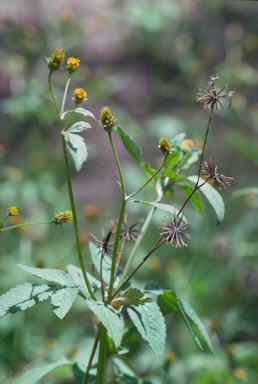
- What is a pest?
- How do pests spread to the islands?
- When pests win, biodiversity loses
- What can you do to be pest-free?
- Proud to be pest free
The Great Barrier Reef World Heritage Area includes more than the reef—it also covers the area’s islands, many of which are further protected as national parks. They are beautiful to see, but even small pests, such as introduced ants, can put these islands at risk.
Currently the Great Barrier Reef islands are the most pest-free islands in the world. You can help to keep them that way. Please play a part before your next trip to the islands. Read the Be pest-free! (PDF, 575KB) brochure for more information.
What is a pest?
Any foreign species, and even native Australian species that occur outside their usual habitat, can become pests. Pests can be animals, including ants, birds, plants, algae, fungi and even bacteria.
How do pests spread to the islands?
Pests can hide in the most unlikely places. If you’ve ever crossed a grassy paddock you’ll know just how many seeds can attach themselves to your socks, shoes or clothing and even after a clean-up, you’d be surprised how many have slipped into a hem of your coat or worked their way into the laces of your shoes.
Campers will know how quickly ants can move into food storage containers and boaties know only too well how small insects and even Asian house geckoes can appear in fishing gear.
Some pests get to the islands by more natural means, such as being washed ashore on flotsam after a cyclone or being carried by winds and deposited in vegetation. There’s a real threat that fire ants Solenopsis invicta or the similar-looking electric ants Wasmannia auropunctata could reach the islands by rafting over on debris.
Overall, the best way for a pest to get to an island is to travel with visitors who unknowingly carry them over to an island and leave them there. Pest plants are very good at hooking onto the clothes and gear of visitors. What’s more, these visitors may go to different islands in the one day or week and are capable of carrying these pests from one island to the next.
When pests win, biodiversity loses
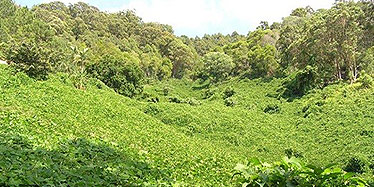
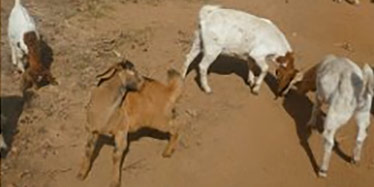
Once on an island, pests can breed usually without any constraints. On islands, the lack of natural checks and balances, such as the presence of natural predators, leaves them free to live and reproduce abnormally.
A population of feral goats can double every 1.6 years. Once loose on an island, they out-compete other native grazers, compact soil and overgraze areas. They are difficult to catch with some almost always escaping musters or aerial shootings. A mixture of control techniques is needed, but these are often expensive and labour intensive.
Pests can reduce food supply, contaminate water, defoliate trees—the island’s ecosystem is thrown out of balance. Life cycles of even the smallest creatures or plants in the ecosystem are interrupted sometimes with catastrophic effects and even local extinctions.
If conditions are suitable, pests can soon become major infestations, and can have a devastating effect if not controlled early.
Pest plants—weeds—grow quickly and often set hundreds and thousands of seeds. Seeds are spread across an island either by wind, water or in some cases of burr or grass seeds, by sticking to the fur or feathers of wildlife. Even our socks and trousers, can carry seeds and drop them off again a distance away.
Pest animals can quickly reach plague proportions if there’s enough food available for them and few, if any, predators. The island life suits some pests more than others, of course.
Every pest affects some part of a life cycle, upsetting the natural balance of the ecosystem. Sometimes the native species are starved of food due to pest invasions, or too many offspring are eaten by pests. Our island ecosystems often have no defences against bigger pests like goats or pigs. These pests change vegetation structure; alter fire regimes; cause erosion; spread diseases and provide opportunities for other pests, particularly weed species.
As the saying goes ‘prevention is the best cure’. So surveillance and quarantine are paramount. So be pest-alert and be pest-free (PDF, 575KB)! when you next visit one of the islands in the Great Barrier Reef.
For more information: view a list of invasive plants and animals that threaten island biosecurity.
What can you do to be pest-free?
Before you visit
- Clean out your camping gear before packing up for a trip to the islands.
- Sweep out tent floors, concentrating on the corners, stitching and hook and loop fasteners such as Velcro.
- Wash down dirty tent poles and pegs to stop soil pathogens spreading onto the islands.
- Give backpacks, raincoats and hats a thorough clean.
- Check and remove seeds and soil from your shoes.
- Ensure no mice, rats, toads, geckoes, ants and other insects (and their eggs) are hiding on your vessel, your aircraft or in your luggage, food, equipment or supplies.
- Leave pets on your vessel or at home. They can harbour fleas, ticks and other pests. Domestic animals aren’t permitted in national parks, or on some beaches adjoining national park islands.
When on an island
- Stay on the marked walking tracks to avoid spreading weeds across the island.
- Always clean up before you move from one island to the next.
Also see
Proud to be pest-free!
The Proud to be pest-free! partner program offers awards to selected government, non-government or commercial organisations, which operate on any Great Barrier Reef island and undertake outstanding biosecurity measures.
Curtis Ferry Services
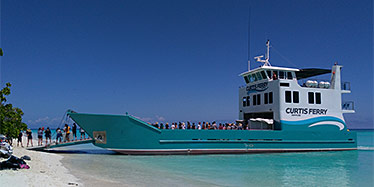
Curtis Ferry Services is the primary Gladstone-based commercial barge provider, servicing all the way from the Keppel Islands in the north of Queensland’s waters to Lady Elliott Island in the south. While its inshore operations to Curtis and Facing Islands near Gladstone are significant, it is their regular operations to offshore national park and other islands that make this company probably the most significant ‘Be Pest-Free!’ commercial operator in all of the Great Barrier Reef (GBR).
The Capricorn Cays are the most important island group in the Great Barrier Reef World Heritage Area because of their outstanding seabird and marine turtle habitat values. Curtis Ferries provides over 50 camper ‘drop-offs’ a year to these outstanding islands, together with regular freight services to island resorts. Their ongoing commitment to ‘Be Pest-Free!’ helps to ensure that the outstanding landscape and natural values of the Capricorn Cays are not compromised by new pest animals, insects and weeds.
Read more about Curtis Ferry Services.
Lizard Island Research Station (LIRS)
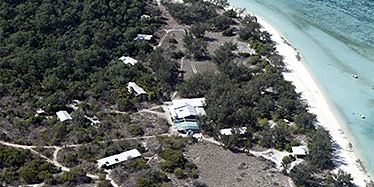
The Lizard Island Research Station is a coral reef research facility that is owned and operated by the Australian Museum. It enables cost-effective research and education about coral reefs by providing accommodation, boats, diving gear, laboratories and a seawater aquarium system to researchers and student groups. LIRS aim to be a world-leading supplier of on-reef facilities for coral reef research and education. To achieve this, they:
- value their customers and their work, and rate service to them as the highest priority
- maintain the local island and marine ecosystem in excellent condition by careful management of the Station's marine and land-based activities, and by close liaison with reef management authorities
- continually improve and upgrade facilities.
To maintain the National Park island ecosystem, Lizard Island Research Station is committed to developing, practising and reviewing island biosecurity procedures. They understand how new pests such as tramp ants, rodents, cane toads and weeds (that can easily hide in freight and equipment transported to the island) can have devastating impacts on island ecology. Lizard Island Research Station has set a BPF benchmark (for an island-based stakeholder) in developing, promoting and practising their own (voluntary) Island Biosecurity Plan, while projecting a powerful BPF influence to other Lizard Island stakeholders (including QPWS).
Read more about Lizard Island Research Station.
North Keppel Island Environmental Education Centre (NKIEEC)
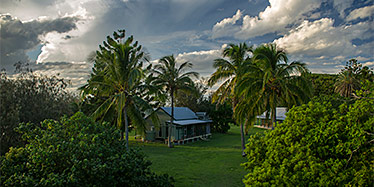
This Education Queensland centre is only 11km off Yeppoon, near Rockhampton, which is a city on the central Queensland coast. It is set in a national park and surrounded by the waters of the Great Barrier Reef Marine Park. Access is by boat only. Visitors, many of them school groups, can experience a range of activities, such as snorkelling, canoeing, marine studies and investigating energy efficiency practices.
The centre focuses on environmental and Indigenous Cultural education through active participation and direct experience. Classes from about 50 or 60 schools, travelling from areas between South East Queensland and Mackay and west to Mount Isa, visit the centre every year. The centre has developed and applies its own (voluntary) Island Biosecurity Plan, which includes encouraging visiting schools to undertake pre-visit studies and adopt island biosecurity practices before they arrive at the mainland terminal for their island departure. NKIEEC staff interpret and reinforce ‘Be-Pest Free!’ principles and procedures to visitors before boarding the boat, upon island arrival, and during classroom and practical sessions while on North Keppel Island.
Read more about North Keppel Island Environmental Education Centre.
Lady Elliot Island Eco Resort
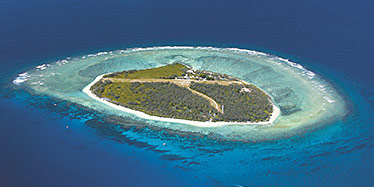
Lady Elliot Island is a coral cay located at the southern tip of the World Heritage-listed Great Barrier Reef, off the Queensland Coast in Australia. The reef surrounding Lady Elliot Island is a sanctuary for over 1200 species of marine life and is known for its abundance of manta rays, turtles and unspoilt coral reef. It is protected within a marine park green zone.
Peter Gash, the Managing Director and current leaseholder, took over the management of Lady Elliot Island Eco Resort (LEIER) in 2005 and has made a number of sweeping changes to make the resort a world class, award winning, ecologically sustainable tourism destination. His mission is for LEIER to play a custodial role on the island and enable it to be preserved as nature intended, while giving visitors the opportunity to experience it in an economically and ecologically viable way without interfering or having any adverse impact upon the long-term sustainability of the island’s unique ecosystem.
Peter and his partners reinvest all profits into the improvement of the resort for the benefit of staff, guests and the environment. Their aim is to be part of the solution to mitigate climate change through eco initiatives such as renewable energy generation and a revegetation program. Solar panels and battery storage already powers 80% of the resort’s energy needs in line with their goal of 100% use of renewable energy by 2020.
The island had once been stripped bare during guano mining and then colonised by weeds. LEIER’s revegetation program aims to bring Lady Elliot Island back to an almost pristine state, through the removal of introduced pest animal and plant species in addition to the propagation and planting of native plants.
An important component of pest control is to prevent new pests such as cane toads, rats and weeds reaching the island. So, to that end, LEIER encourage and implement quarantine and surveillance procedures for all aircraft, barge and other boat arrivals to ensure the island can ‘Be Pest-Free!’
Read more about Lady Elliot Island Eco Resort.


